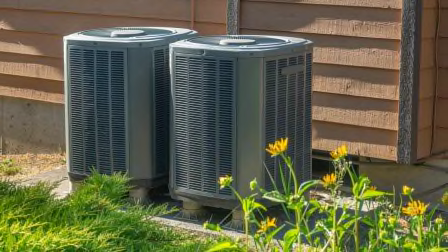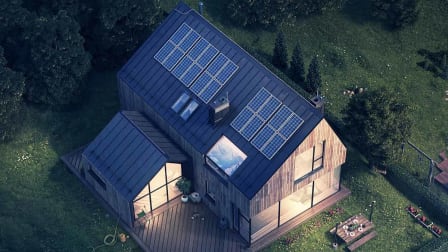How the Solar Tax Credit Works
Here's what you need to know about the 30 percent credit for residential installations, and who will benefit the most

The federal solar tax credit is a big boon to homeowners who want to add solar panels to their home. But those who will reap the most benefit include those who pay a lot for their electricity (or expect to in the future); those who usually owe the IRS at tax time; those who plan to buy (not lease) solar panels; and those who expect to stay put in their homes for a while.
The solar tax credit, which is among several federal Residential Clean Energy Credits available through 2032, allows homeowners to subtract 30 percent of the cost of installing solar heating, electricity generation, and other solar home products from their federal taxes.
The credit has helped reduce the average price of a solar panel installation to $20,650 from more than $50,000 10 years ago, says EnergySage, an alternative energy marketplace. The average homeowner, it adds, could break even on the investment in 8.7 years. While that’s a lofty price tag and a fairly long wait for a return on investment, the savings could be greater—and the break-even point sooner—if, among other factors, you pay more than the average in electricity costs and can benefit from state tax incentives. (Use EnergySage’s solar calculator to estimate when you’d break even.)
And because the credit will be available to taxpayers for nearly a decade, homeowners considering a solar installation have plenty of time to consider their options and look for the best solar deals.
Here are key details.
What Is the Solar Tax Credit?
If you install solar energy equipment in your residence any time this year through the end of 2032, you are entitled to a nonrefundable credit off your federal income taxes equal to 30 percent of eligible expenses. There’s no dollar limit on those expenses; you’re entitled to that 30 percent tax break whether you spend $20,000 or more than $100,000 on costs associated with a residential solar system.
How to Take Advantage of Federal Energy Tax Breaks
CR explains how buying a heat pump for your home could get you thousands of dollars in federal tax credits and state rebates. We also fill you in on credits and rebates for electric cooking appliances and which cars qualify for the electric vehicle tax credit.
What Expenses Are Eligible for the Solar Tax Credit?
According to the Internal Revenue Service, these expenses are eligible for the solar tax credit:
- Solar photovoltaic (PV) panels.
- PV cells used to power an attic fan (but not the fan itself).
- Contractor labor for on-site preparation, assembly, or original installation.
- Permitting fees, inspection costs, and developer fees.
- All equipment needed to get the solar system running, including wiring, inverters, and mounting equipment.
- Storage batteries. (You can claim the tax credit for these even if you buy and install them a year or more after you install the solar system; eligible units must store at least 3 kilowatts.)
- Sales taxes on eligible expenses.
How Will the Solar Tax Credit Save You Money?
The credit lowers your federal taxes. So if you spend $24,000 on a system, you can subtract 30 percent of that, or $7,200, from the federal taxes you owe. (You must take the credit for the year the installation is completed.) If, say, you would owe $7,000 in taxes before the credit, a $7,200 credit would drop what you owe to zero. You can’t get a tax refund for the $200 remainder, but you can carry forward that remaining credit into a later tax year.
You’ll save, too, in lower electricity bills. How much you’ll save depends on a number of factors, including how much electricity your household uses, the size of your solar system and the amount of sunlight it gets, and local electricity rates. Real estate experts say a purchased solar system—as opposed to a leased one—can raise the value of your home when you sell.
How Long Does the Solar Tax Credit Last?
The 30 percent credit lasts until Dec. 31, 2032. It drops to 26 percent in 2033, then 22 percent in 2034, and disappears in 2035, unless Congress continues it. (The law that provides for this credit supersedes an older law, set to expire in 2024, that would have provided a 26 percent credit for solar installations this year, and 22 percent in 2023.)
Who Can Get the Solar Tax Credit?
It’s available to all taxpayers for their primary or secondary residence located in the U.S. Taxpayers of any income level can take advantage of it. You can use it whether you itemize your taxes or take the standard deduction.
Keep in mind, though, that the solar tax credit is available only if you purchase a solar system; if you lease one, you can’t take advantage of the credit. The same applies if you are a member of a power-purchasing cooperative. However, if you are a tenant-stakeholder in a co-op, you can claim credit for your portion of the purchase. You can also claim credit for your portion of the purchase of a community-owned solar system.
Do You Still Get the Federal Tax Credit If Your State Also Offers One?
Your federal tax credit isn’t reduced by any solar tax credit your state may offer. But it will be up to your state’s taxing authority whether your state credit is reduced if you take advantage of the federal one.
New York, for example, does not cut its solar incentives for people who take advantage of federal ones; state residents can credit 25 percent of qualified solar energy system equipment expenditures from their state taxes, up to $5,000. You don’t get a refund if that amount is more than what you’d owe, but you can carry over the difference for up to five years.
Can You Use This Credit If You Also Use Other Federal Energy Tax Credits?
Yes. You also can take advantage of the federal Nonbusiness Energy Property Credit, which covers other qualifying efficiency upgrades, such as Energy Star certified exterior windows, Energy Star certified exterior doors, air-sealing insulation, upgraded electrical circuit panels, and heat pumps. You can claim both credits on your federal return—either in the same year or different years, depending on when the installations are completed.




















